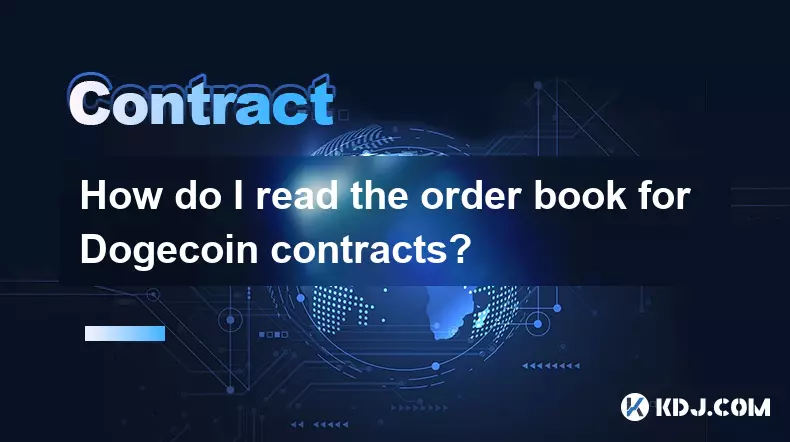-
 bitcoin
bitcoin $122090.672462 USD
1.59% -
 ethereum
ethereum $4493.758974 USD
0.56% -
 xrp
xrp $3.033145 USD
0.65% -
 tether
tether $1.000629 USD
0.00% -
 bnb
bnb $1169.854250 USD
7.07% -
 solana
solana $230.954786 USD
-0.19% -
 usd-coin
usd-coin $0.999785 USD
0.00% -
 dogecoin
dogecoin $0.256108 USD
-1.12% -
 tron
tron $0.342333 USD
-0.12% -
 cardano
cardano $0.859632 USD
-0.10% -
 hyperliquid
hyperliquid $48.932146 USD
-2.25% -
 chainlink
chainlink $22.345466 USD
-1.29% -
 ethena-usde
ethena-usde $1.000217 USD
-0.03% -
 avalanche
avalanche $31.203456 USD
1.93% -
 sui
sui $3.579145 USD
1.05%
How do I read the order book for Dogecoin contracts?
The Dogecoin contract order book reveals real-time buy/sell interest, with bid-ask spread and depth indicating liquidity, while sudden order changes may signal manipulation or breakout potential.
Oct 03, 2025 at 03:54 pm

Understanding the Structure of a Dogecoin Contract Order Book
1. The order book for Dogecoin contracts displays a real-time list of buy and sell orders organized by price level. On the left side, you typically see the bid prices—these are the prices at which traders are willing to buy Dogecoin futures or perpetual contracts. On the right, the ask prices represent where traders aim to sell. Each side lists the quantity available at each price point, giving a clear picture of market depth.
2. Prices are arranged in descending order on the bid side and ascending on the ask side, with the best (highest) bid and best (lowest) ask closest to the middle. This central spread is critical—it reflects the current supply and demand equilibrium. A narrow spread often indicates high liquidity and active trading, while a wide spread may suggest volatility or low participation.
3. Market makers contribute significantly to the order book by placing limit orders that add depth. Their presence helps stabilize pricing and reduces slippage for larger trades. Observing how quickly orders are filled or canceled can offer insight into whether the market is dominated by algorithmic strategies or retail sentiment.
Interpreting Volume and Liquidity Signals
1. The cumulative volume displayed at various price levels reveals where significant interest lies. Large clusters of buy orders below the current price may act as support zones, suggesting traders anticipate value at those levels. Conversely, dense sell walls above the market price could indicate resistance, where profit-taking or short positions are concentrated.
2. Sudden spikes in order size at specific prices often reflect institutional activity or coordinated trading behavior. These imbalances can precede sharp price movements if they are aggressively executed. Watching for rapid deletions of large orders might signal spoofing attempts, where false demand or supply is created to manipulate perception.
Traders who monitor changes in volume distribution over time gain an edge in anticipating breakouts or reversals based on shifting market structure.3. Depth charts, which visualize the order book as a line graph, allow for quicker assessment of imbalance. A steep rise on the buy side shows strong accumulation potential, while a sharp incline on the sell side warns of imminent downward pressure if those orders execute.
Using Order Flow to Predict Short-Term Price Action
1. Real-time order flow analysis involves tracking the sequence and size of executed trades against the order book. Aggressive buying—where market orders consume multiple layers of asks—often drives upward momentum. Similarly, sustained selling through bid layers can trigger cascading liquidations in leveraged markets.
2. Hidden liquidity, such as iceberg orders that reveal only a fraction of their total size, can distort surface-level interpretation. Platforms with advanced data feeds may expose these patterns, enabling more accurate forecasting of sustained pressure points.
3. Time & Sales data, when correlated with the order book, highlights whether large transactions occur at bid, ask, or mid-price. Repeated fills at the ask suggest aggressive demand, potentially foreshadowing bullish continuation, especially if new highs in volume accompany them.
Persistent absorption of large sell orders without price depreciation indicates strong underlying demand, often seen before explosive rallies.Identifying Manipulation and False Signals
1. Spoofing remains prevalent in crypto derivatives markets, including Dogecoin contracts. Traders place large orders not intended for execution, aiming to create illusions of supply or demand. When these orders vanish before trade, it's a red flag of manipulative intent.
2. Whale watching tools help identify accounts placing disproportionate orders. While not inherently malicious, sudden appearance of massive bids or offers from known entities can influence crowd psychology and trigger reflexive moves.
3. Discrepancies between the order book and actual trade volume may indicate synthetic pressure. If the top of the book shows thick sell walls but trades continue clearing above without resistance, the wall may be illusory or easily overcome.
Frequently Asked Questions
What does a thin order book mean for Dogecoin contracts?A thin order book indicates limited buy and sell orders near the current price, leading to higher volatility and increased slippage. Small trades can cause outsized price swings, making execution riskier, especially for large positions.
How can I tell if the order book is being manipulated?Frequent appearance and cancellation of large orders, especially on one side of the book, suggest possible spoofing. Cross-referencing with trade volume and using order flow analytics can help detect unnatural patterns inconsistent with organic market behavior.
Why do some Dogecoin contract order books show negative funding rates?Negative funding rates occur when short positions pay longs, indicating bearish sentiment dominates the market. This often happens during downtrends or periods of heightened pessimism, reflecting more traders betting on price declines.
Can I rely solely on the order book for trading decisions?While the order book provides valuable real-time insights, it should be combined with other tools like price action, volume profiles, and on-chain metrics. Relying exclusively on order book data risks misinterpreting transient noise as meaningful structural shifts.
Disclaimer:info@kdj.com
The information provided is not trading advice. kdj.com does not assume any responsibility for any investments made based on the information provided in this article. Cryptocurrencies are highly volatile and it is highly recommended that you invest with caution after thorough research!
If you believe that the content used on this website infringes your copyright, please contact us immediately (info@kdj.com) and we will delete it promptly.
- BlockDAG, DOGE, HYPE Sponsorship: Crypto Trends Shaping 2025
- 2025-10-01 00:25:13
- Deutsche Börse and Circle: A StableCoin Adoption Powerhouse in Europe
- 2025-10-01 00:25:13
- BlockDAG's Presale Buzz: Is It the Crypto to Watch in October 2025?
- 2025-10-01 00:30:13
- Bitcoin, Crypto, and IQ: When Genius Meets Digital Gold?
- 2025-10-01 00:30:13
- Stablecoins, American Innovation, and Wallet Tokens: The Next Frontier
- 2025-10-01 00:35:12
- NBU, Coins, and Crypto in Ukraine: A New Yorker's Take
- 2025-10-01 00:45:14
Related knowledge

What is the difference between futures and perpetual contracts for Bitcoin?
Oct 02,2025 at 11:54pm
Understanding Bitcoin Futures Contracts1. Bitcoin futures are derivative instruments that allow traders to speculate on the future price of Bitcoin at...

What is the best time to trade PEPE contracts?
Oct 03,2025 at 11:54am
Understanding PEPE Contract Volatility1. PEPE contracts exhibit extreme price fluctuations due to their meme-based nature and low market cap. Trading ...

What are the common mistakes to avoid with Bitcoincoin contracts?
Oct 03,2025 at 08:54am
Emerging Trends in the Cryptocurrency Market1. Decentralized finance (DeFi) platforms continue to expand their influence across the blockchain ecosyst...

What is the maintenance margin for Bitcoin contracts?
Oct 02,2025 at 01:36am
Decentralized Exchanges Gain Momentum in 20241. Decentralized exchanges (DEXs) have seen a significant rise in trading volume, surpassing centralized ...

How to use technical analysis for trading XRP contracts?
Oct 03,2025 at 01:18pm
Understanding Price Patterns in XRP Futures1. Identifying chart patterns such as triangles, head and shoulders, and double tops or bottoms can provide...

What does "longing" PEPE contracts mean?
Oct 03,2025 at 11:54pm
Understanding Decentralized Exchanges in the Crypto Ecosystem1. Decentralized exchanges (DEXs) operate without a central authority, allowing users to ...

What is the difference between futures and perpetual contracts for Bitcoin?
Oct 02,2025 at 11:54pm
Understanding Bitcoin Futures Contracts1. Bitcoin futures are derivative instruments that allow traders to speculate on the future price of Bitcoin at...

What is the best time to trade PEPE contracts?
Oct 03,2025 at 11:54am
Understanding PEPE Contract Volatility1. PEPE contracts exhibit extreme price fluctuations due to their meme-based nature and low market cap. Trading ...

What are the common mistakes to avoid with Bitcoincoin contracts?
Oct 03,2025 at 08:54am
Emerging Trends in the Cryptocurrency Market1. Decentralized finance (DeFi) platforms continue to expand their influence across the blockchain ecosyst...

What is the maintenance margin for Bitcoin contracts?
Oct 02,2025 at 01:36am
Decentralized Exchanges Gain Momentum in 20241. Decentralized exchanges (DEXs) have seen a significant rise in trading volume, surpassing centralized ...

How to use technical analysis for trading XRP contracts?
Oct 03,2025 at 01:18pm
Understanding Price Patterns in XRP Futures1. Identifying chart patterns such as triangles, head and shoulders, and double tops or bottoms can provide...

What does "longing" PEPE contracts mean?
Oct 03,2025 at 11:54pm
Understanding Decentralized Exchanges in the Crypto Ecosystem1. Decentralized exchanges (DEXs) operate without a central authority, allowing users to ...
See all articles










































































